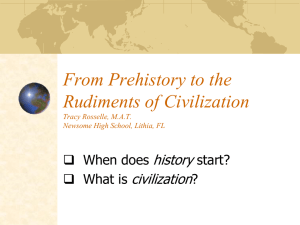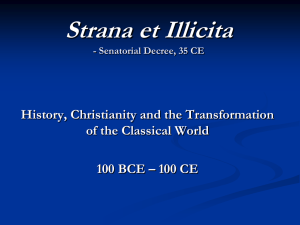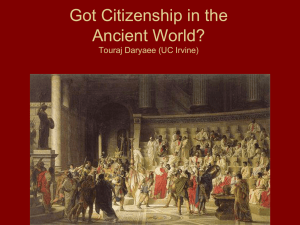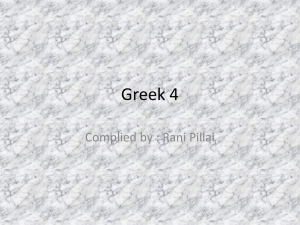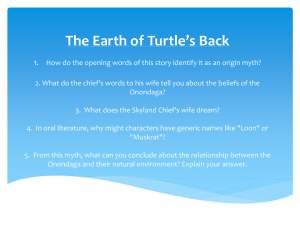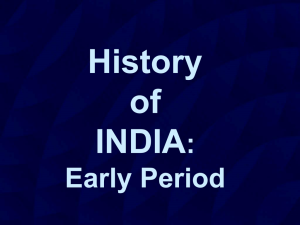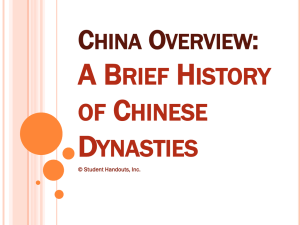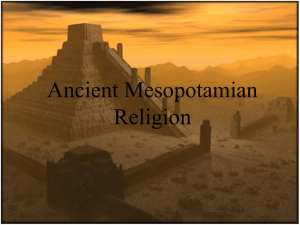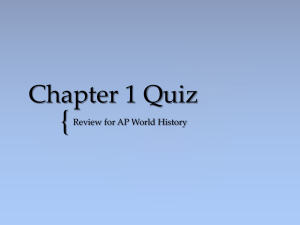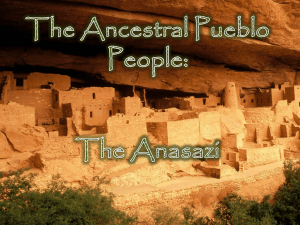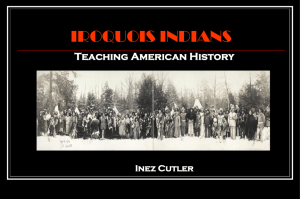Pre-Columbian America
advertisement
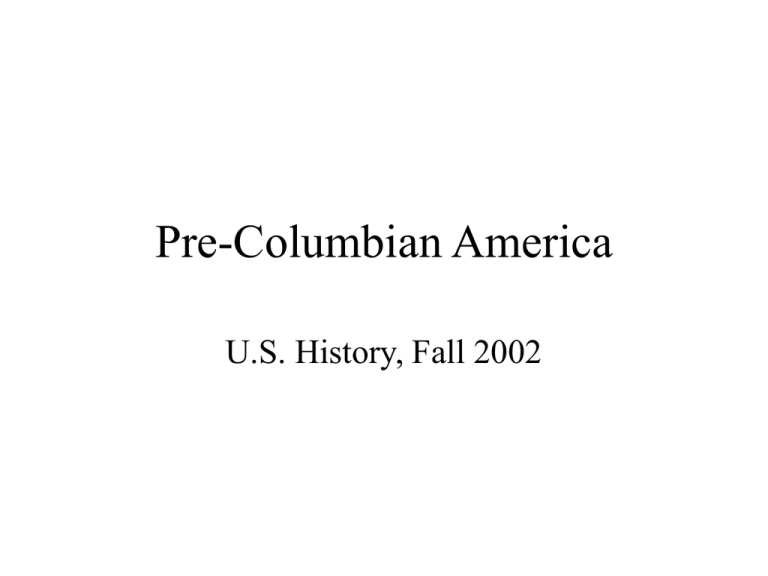
Pre-Columbian America U.S. History, Fall 2002 • Problem of Prehistory • First Immigrants and Major Eras • Cultural Diversity in Post-Archaic Period – Mississippian: Cahokia and Hopewell – Eastern Woodlands: Iroquois – The Southwest: Anasazi Problem of Prehistory 1. Primarily non-literate: very few documents for historians to examine • European conquerors systematically destroyed many of the documents that existed Problem of Prehistory 1. Primarily non-literate: very few documents for historians to examine • European conquerors systematically destroyed many of the documents that existed 2. European bias: • most of the existing documents that describe Indian cultures written by Europeans or by Indians being watched by Europeans Problem of Prehistory 1. Primarily non-literate: very few documents for historians to examine • European conquerors systematically destroyed many of the documents that existed 2. European bias: • most of the existing documents that describe Indian cultures written by Europeans or by Indians being watched by Europeans 3. Break with oral culture: • religious conversion, demographic collapse, and loss of culture makes evidence from Indian oral tradition problematic Problem of Prehistory 1. 2. 3. Primarily non-literate: very few documents for historians to examine • European conquerors systematically destroyed many of the documents that existed European bias: • most of the existing documents that describe Indian cultures written by Europeans or by Indians being watched by Europeans Break with oral culture: • religious conversion, demographic collapse, and loss of culture makes evidence from Indian oral tradition problematic Therefore: Archaeology, Carbon-14 dating, dendrochronology First Immigrants and Major Eras 1. Beringia (30,000-12,000 BCE) First Immigrants and Major Eras 1. Beringia (30,000-12,000 BCE) 2. Paleo-Indian (12-8,000 BCE) First Immigrants and Major Eras 1. Beringia (30,000-12,000 BCE) 2. Paleo-Indian (12-8,000 BCE) 3. Archaic/Neolithic (8,000-500 BCE) First Immigrants and Major Eras 1. 2. 3. 4. Beringia (30,000-12,000 BCE) Paleo-Indian (12-8,000 BCE) Archaic/Neolithic (8,000-500 BCE) Post-Archaic (500 BCE-Contact) Beringia (30-12,000 BCE) Last Major Ice Age: Expanded ice caps suck up the oceans’ waters and lowers sea level (global warming in reverse) Beringia (30-12,000 BCE) Last Major Ice Age: Expanded ice caps suck up the oceans’ waters and lowers sea level (global warming in reverse) Land bridge created between Asia and North America Beringia (30-12,000 BCE) Last Major Ice Age: Expanded ice caps suck up the oceans’ waters and lowers sea level (global warming in reverse) Land bridge created between Asia and North America Old and New Worlds meet for first time in millions of years (since Pangean supercontinent broke up) 100 Million Years Ago Present Day Continents Beringia (30-12,000 BCE) Last Major Ice Age: Expanded ice caps suck up the oceans’ waters and lowers sea level (global warming in reverse) Land bridge created between Asia and North America Old and New Worlds meet for first time in millions of years (since Pangean supercontinent broke up) Indians enter a world without humans, and so have many advantages in conquering the continents Mammoths on the Land Bridge Paleo-Indian (12-8,000 BCE) • Technological breakthrough: Flaked point spearpoints (Clovis, Folsom) Paleo-Indian (12-8,000 BCE) • Technological breakthrough: Flaked point spearpoints (Clovis, Folsom) food sources more reliable Paleo-Indian (12-8,000 BCE) • Technological breakthrough: Flaked point spearpoints (Clovis, Folsom) food sources more reliable more stable habitation Paleo-Indian (12-8,000 BCE) • Technological breakthrough: Flaked point spearpoints (Clovis, Folsom) food sources more reliable more stable habitation population increases Archaic/Neolithic (8,000-500 BCE) • Warming climate and “Pleistocene Overkill” Archaic/Neolithic (8,000-500 BCE) • Warming climate and “Pleistocene Overkill” dwindling game supply Archaic/Neolithic (8,000-500 BCE) • Warming climate and “Pleistocene Overkill” dwindling game supply transition to agriculture (the “Neolithic revolution”) Archaic/Neolithic (8,000-500 BCE) • Central Mexicans were the first to transition to agriculture around 7,000 BCE (maize) Archaic/Neolithic (8,000-500 BCE) • Central Mexicans were the first to transition to agriculture around 7,000 BCE (maize) slowly spreads outward (primarily by the efforts of women) Archaic/Neolithic (8,000-500 BCE) • Central Mexicans were the first to transition to agriculture around 7,000 BCE (maize) slowly spreads outward (primarily by the efforts of women) Demands of farming (long period between planting and farming, need for irrigation)more complex societies, hierarchy, specialization, trade Post-Archaic (500 BCE-Contact) Marked by growing cultural diversity: • 9 major cultural groups • 2,000 cultures Cultural Diversity in the PostArchaic Period Diversity between and within groups increased • Diversity between groups facilitated by many different ecological/climate zones in the Americas Arctic Temperate Tropical Tropical Arctic Climate Zones Cultural Diversity in the PostArchaic Period Diversity between and within groups increased • Diversity between groups was facilitated by many different ecological/climate zones in the Americas • Diversity within groups grew through trade and specialization: individuals focused on their particular skills (politics, pottery, hunting, art, religion, jewelry) Cultural Diversity: Mississippian/Hopewell • Major trading culture that dominated from Wisconsin to Louisiana Cultural Diversity: Mississippian/Hopewell • Major trading culture that dominated from Wisconsin to Louisiana • Major urban area: Cahokia: trading/political/religious center – 30,000 residents in 1200 AD Cahokia Burial Mound Geometric Mounds Animal Mounds Collapse of Mississippian/Hopewell Cahokia eventually collapsed in part because the Indians over-farmed the area and could no longer support such a large, urban population. Competition from neighboring tribes and disease introduced by Europeans also may have led to their collapse. Cultural Diversity: Iroquois • The Iroquois lived in the Great Lakes Region and were primarily hunters and gatherers, although they farmed to a limited degree Cultural Diversity: Iroquois • The Iroquois lived in the Great Lakes Region and were primarily hunters and gatherers, although they farmed to a limited degree • They lived in villages made of wooden longhouses Iroquois Man Cultural Diversity: Iroquois • Iroquois society appears to have been matrilineal: property was owned by women and was passed from mother to daughter; women had important powers in society Iroquois Woman Cultural Diversity: Iroquois • The Iroquois League brought together the Six Nations into a political and military alliance • The Iroquois went to war with their neighbors, especially in order to kidnap Indians who would often be adopted into Iroquois society • The Iroquois were feared by many other tribes in the Great Lakes Region (some of whom would align with the Europeans for protection against the Iroquois) Cultural Diversity: Anasazi • The Anasazi are the ancestors of the Hopi and Pueblo peoples of the American Southwest • The Anasazi built some of the most populated cities in the world at the height of their civilization Chaco Canyon • The largest Anasazi community was Chaco Canyon, an area in present-day northwestern New Mexico that contained 12 cities. Chaco Canyon Anasazi • The Anasazi were also famous for building into the sides of cliffs, partly as defense, partly in order to enable massive buildings. Bandelier Mountain: An Anasazi Suburb • Bandelier Mountain (which is actually a canyon) was a settlement south of Chaco Canyon that was the site of the world’s largest apartment complex until beat out by one built in NYC in 1880. Bandelier Mountain Anasazi: Collapse • The Anasazi culture collapse and the population dispersed into the smaller Hopi and Pueblo cultures in part because of a sustained drought (see Cahokia) and because of European incursions. Summary • Native American peoples conquered a hitherto unsettled land when a land bridge opened to the New World in the last Ice Age. • Spreading across many different ecological zones, the Native Americans developed an astonishingly diverse set of cultures, from settled agriculture to nomadic hunting and gathering. It is therefore incorrect to speak of an “Indian culture” or even of a single Indian “people.”
